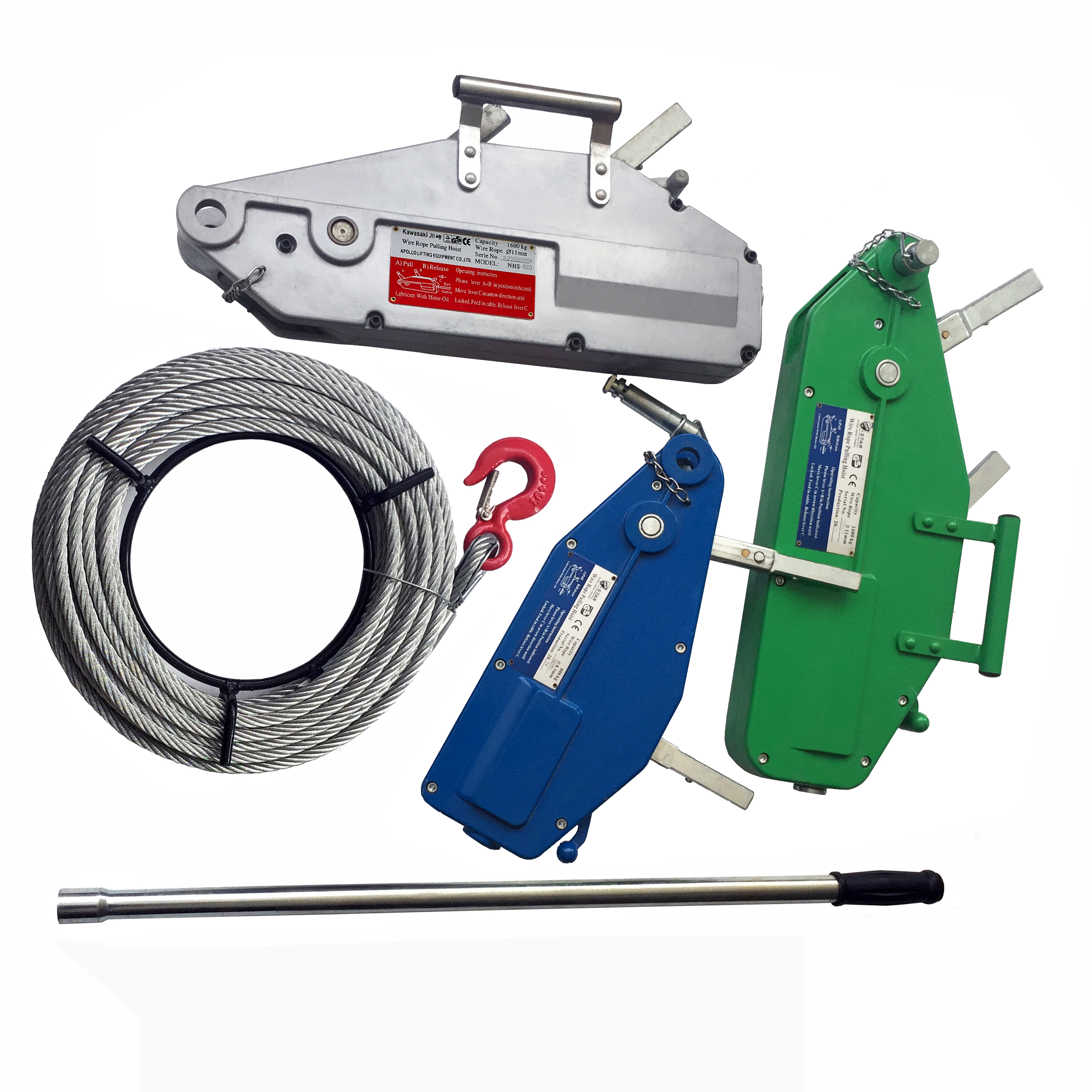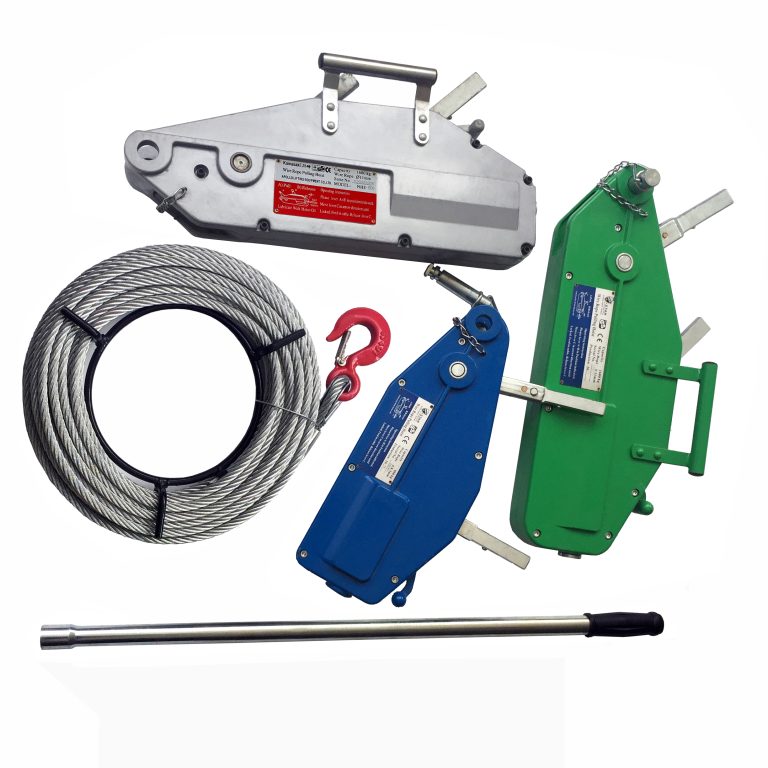A steel wire rope hand hoist is a manual lifting device widely used in construction, warehousing, shipbuilding, transportation, and mechanical maintenance. Known for its compact structure, high efficiency, and portability, it is ideal for lifting, pulling, tensioning, and positioning heavy loads in various environments where power sources may not be available.
This article provides a comprehensive overview of the usage method and precautions required to ensure the safe and effective operation of a steel wire rope hand hoist.
1. Structure and Working Principle
Before delving into the usage, it is essential to understand the basic structure and working principle of the hand hoist.
Key Components
-
Main body/housing: Encloses the internal gear mechanism.
-
Wire rope: Made of high-tensile steel, flexible yet strong.
-
Jaw mechanism (clamping system): Grips the rope and allows linear motion.
-
Handle/Lever: Operated manually to transfer force.
-
Forward and reverse switch: For lifting (forward) or lowering (reverse) the load.
-
Anchor hook or eye: Secures the hoist in place during use.
Working Principle
The hoist operates on a mechanical advantage system, using a ratchet-and-pawl mechanism. The operator pushes or pulls the lever handle, engaging the clamping jaws on the wire rope. With each stroke, the rope moves through the jaws, lifting or pulling the load incrementally.
2. Usage Method
Step-by-Step Operation
Step 1: Inspection Before Use
-
Visual inspection: Check the wire rope for kinks, broken strands, rust, or deformation.
-
Hoist body: Inspect for cracks, wear, and smooth operation of levers and switches.
-
Load capacity: Ensure the hoist’s rated capacity matches or exceeds the intended load.
Step 2: Setting Up
-
Anchor the hoist: Secure the hoist to a fixed point using the anchor hook or a stable support structure.
-
Insert the wire rope: Pass the steel wire rope through the jaw mechanism according to the manufacturer’s guidelines.
-
Direction selector: Set the selector to the correct direction—“up” for lifting or “down” for lowering.
Step 3: Operating the Hoist
-
Pull the lever: Move the handle back and forth in a steady rhythm. Each stroke pulls the rope and moves the load.
-
Load control: To stop, simply stop moving the handle. The jaw mechanism locks the rope, holding the load in place.
-
Adjusting direction: To reverse, change the selector switch and operate the handle as usual.
Step 4: Removing the Load
-
Lower the load: Carefully lower the load to its resting place by operating the handle in the reverse direction.
-
Disengage the rope: Once the rope is slack, remove it from the jaw mechanism.
-
Storage: Clean and store the hoist and rope in a dry, safe place.
3. Precautions
Ensuring safety during the operation of a steel wire rope hand hoist is paramount. The following precautions must be followed to prevent accidents and equipment damage.
A. General Safety Precautions
-
Rated Load Compliance
-
Never exceed the rated lifting capacity of the hoist.
-
Overloading can lead to mechanical failure or wire rope breakage.
-
-
Qualified Personnel
-
Only trained and authorized personnel should operate the hoist.
-
Operators should understand the mechanical principles and emergency procedures.

-
-
Regular Inspection and Maintenance
-
Conduct pre-use and periodic inspections.
-
Replace worn or damaged components immediately.
-
B. Wire Rope Handling
-
Avoid Abrasion and Kinking
-
Do not drag the wire rope over rough surfaces.
-
Avoid sharp bends that can damage the wire strands.
-
-
Proper Storage
-
Store in a clean, dry place to prevent rusting.
-
Use reels or coils to maintain the rope’s shape and integrity.
-
-
Keep Clean and Lubricated
-
Clean the rope regularly to remove dirt or corrosive materials.
-
Apply proper lubrication to reduce wear.
-
C. Setup Precautions
-
Secure Anchoring
-
Ensure the anchor point is stable and strong enough to handle the load.
-
Avoid makeshift anchoring which may fail under tension.
-
-
Correct Installation
-
Make sure the wire rope is installed without twists.
-
Check the locking mechanism is functioning before applying load.
-
-
Positioning
-
Position the hoist so that the load is lifted vertically to avoid side loading, which can destabilize the hoist or cause the rope to slip.
-
D. During Operation
-
Smooth Operation
-
Use slow and consistent strokes of the handle.
-
Avoid jerky movements that can shock-load the system.
-
-
Clear Work Area
-
Keep bystanders away from the operation zone.
-
Mark the lifting area with warning signs if needed.
-
-
Avoid Sudden Load Release
-
Never release the load suddenly. It can swing, fall, or damage surrounding objects.
-
-
Monitor Load Behavior
-
Watch for signs of imbalance, shifting, or slipping.
-
Stop the operation immediately if any irregularities occur.
-
E. Environmental Considerations
-
Weather Conditions
-
Avoid operating in severe weather (heavy rain, lightning, or strong wind).
-
Wet conditions can make the rope slippery and reduce friction in the clamping jaws.
-
-
Chemical Exposure
-
Keep away from corrosive chemicals or acidic environments.
-
If exposed, clean and dry the hoist immediately.
-
F. Emergency Procedures
-
If the Load Slips
-
Stop operation and check the clamping mechanism.
-
Do not continue until the issue is fully resolved.
-
-
Rope Breakage
-
Never stand directly under or near the load.
-
In case of a break, report the incident and replace the rope.
-
-
Hoist Malfunction
-
Discontinue use if the handle becomes jammed or movement feels unusual.
-
Have the hoist inspected by a qualified technician.
-
4. Maintenance Guidelines
Regular maintenance extends the service life and ensures safety.
Daily Maintenance
-
Wipe down all parts after use.
-
Lightly lubricate the wire rope and internal gears.
Weekly Checks
-
Inspect jaw clamping force.
-
Check handle for free movement.
Monthly/Quarterly Inspection
-
Perform full inspection of internal components.
-
Replace any parts showing wear beyond safe limits.
Record Keeping
-
Maintain a logbook for inspections, repairs, and incidents.
5. Conclusion
The steel wire rope hand hoist is a versatile and powerful tool for manual lifting and pulling tasks. However, its safe and effective use depends on the operator’s understanding of its mechanics, proper usage, and adherence to safety protocols.
By following the correct usage methods, observing the listed precautions, and adhering to a regular maintenance schedule, users can ensure both maximum performance and safety during operation. Whether on a construction site, in a workshop, or during fieldwork, a steel wire rope hand hoist is an indispensable tool—when used responsibly.


